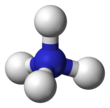
Back هيدروكسيد الأمونيوم Arabic هیدروکسید آمونیوم AZB Аміячная вада Byelorussian অ্যামোনিয়া দ্রবণ Bengali/Bangla Hidròxid d'amoni Catalan Аммиаклă шыв CV Ammoniumhydroxid Danish Ammoniakwasser German Amonia hidroksido Esperanto Hidróxido de amonio Spanish
| |||
| |||
| Names | |||
|---|---|---|---|
| IUPAC name
Ammonium hydroxide
| |||
Other names
| |||
| Identifiers | |||
3D model (JSmol)
|
|||
| ChEBI | |||
| ChemSpider | |||
| ECHA InfoCard | 100.014.225 | ||
| EC Number |
| ||
| E number | E527 (acidity regulators, ...) | ||
| KEGG | |||
PubChem CID
|
|||
| RTECS number |
| ||
| UNII | |||
| UN number | 2672 | ||
CompTox Dashboard (EPA)
|
|||
| |||
| |||
| Properties[1] | |||
| NH3(aq) | |||
| Molar mass | 17.031 g/mol | ||
| Appearance | Colourless liquid | ||
| Odor | "Fishy", highly pungent | ||
| Density | 0.91 g/cm3 (25 % w/w) 0.88 g/cm3 (35 % w/w) | ||
| Melting point | −57.5 °C (−71.5 °F; 215.7 K) (25 % w/w) −91.5 °C (35% w/w) | ||
| Boiling point | 37.7 °C (99.9 °F; 310.8 K) (25 % w/w) | ||
| Miscible | |||
| −31.5×10−6 cm3/mol | |||
| Thermochemistry | |||
Std molar
entropy (S⦵298) |
111 J/(mol·K)[2] | ||
Std enthalpy of
formation (ΔfH⦵298) |
−80 kJ/mol[2] | ||
| Hazards[4][5] | |||
| Occupational safety and health (OHS/OSH): | |||
Main hazards
|
Moderately toxic and irritating towards mucous membranes | ||
| GHS labelling: | |||
   
| |||
| Danger | |||
| H302, H314, H335, H410 | |||
| P261, P271, P273, P280, P303+P361+P353, P305+P351+P338 | |||
| NFPA 704 (fire diamond) | |||
| Lethal dose or concentration (LD, LC): | |||
LD50 (median dose)
|
100 — 200 mg/kg[3] | ||
| Safety data sheet (SDS) | ICSC 0215 (10%-35% solution) | ||
| Related compounds | |||
Other anions
|
Ammonium chloride Ammonium cyanide | ||
Other cations
|
Tetramethylammonium hydroxide | ||
Related compounds
|
Ammonia Hydroxylamine | ||
Except where otherwise noted, data are given for materials in their standard state (at 25 °C [77 °F], 100 kPa).
| |||
Ammonia solution, also known as ammonia water, ammonium hydroxide, ammoniacal liquor, ammonia liquor, aqua ammonia, aqueous ammonia, or (inaccurately) ammonia, is a solution of ammonia in water. It can be denoted by the symbols NH3(aq). Although the name ammonium hydroxide suggests a salt with the composition [NH+
4][OH−
], it is actually impossible to isolate samples of NH4OH. The ions NH+
4 and OH− do not account for a significant fraction of the total amount of ammonia except in extremely dilute solutions.[6]
The concentration of such solutions is measured in units of the Baumé scale (density), with 26 degrees Baumé (about 30% of ammonia by weight at 15.5 °C or 59.9 °F) being the typical high-concentration commercial product.[7]
- ^ Record of Ammonia solution in the GESTIS Substance Database of the Institute for Occupational Safety and Health .
- ^ a b Zumdahl, Steven S. (2009). Chemical Principles 6th Ed. Houghton Mifflin Company. p. A22. ISBN 978-0-618-94690-7.
- ^ Ammonium hydroxide toxicity
- ^ C&L Inventory.
- ^ "GESTIS-Stoffdatenbank". gestis.dguv.de.
- ^ Housecroft, C. E.; Sharpe, A. G. (2004). Inorganic Chemistry (2nd ed.). Prentice Hall. p. 187. ISBN 978-0-13-039913-7.
- ^ "Ammonium hydroxide physical properties" (PDF). Archived from the original (PDF) on 27 November 2007.
© MMXXIII Rich X Search. We shall prevail. All rights reserved. Rich X Search




